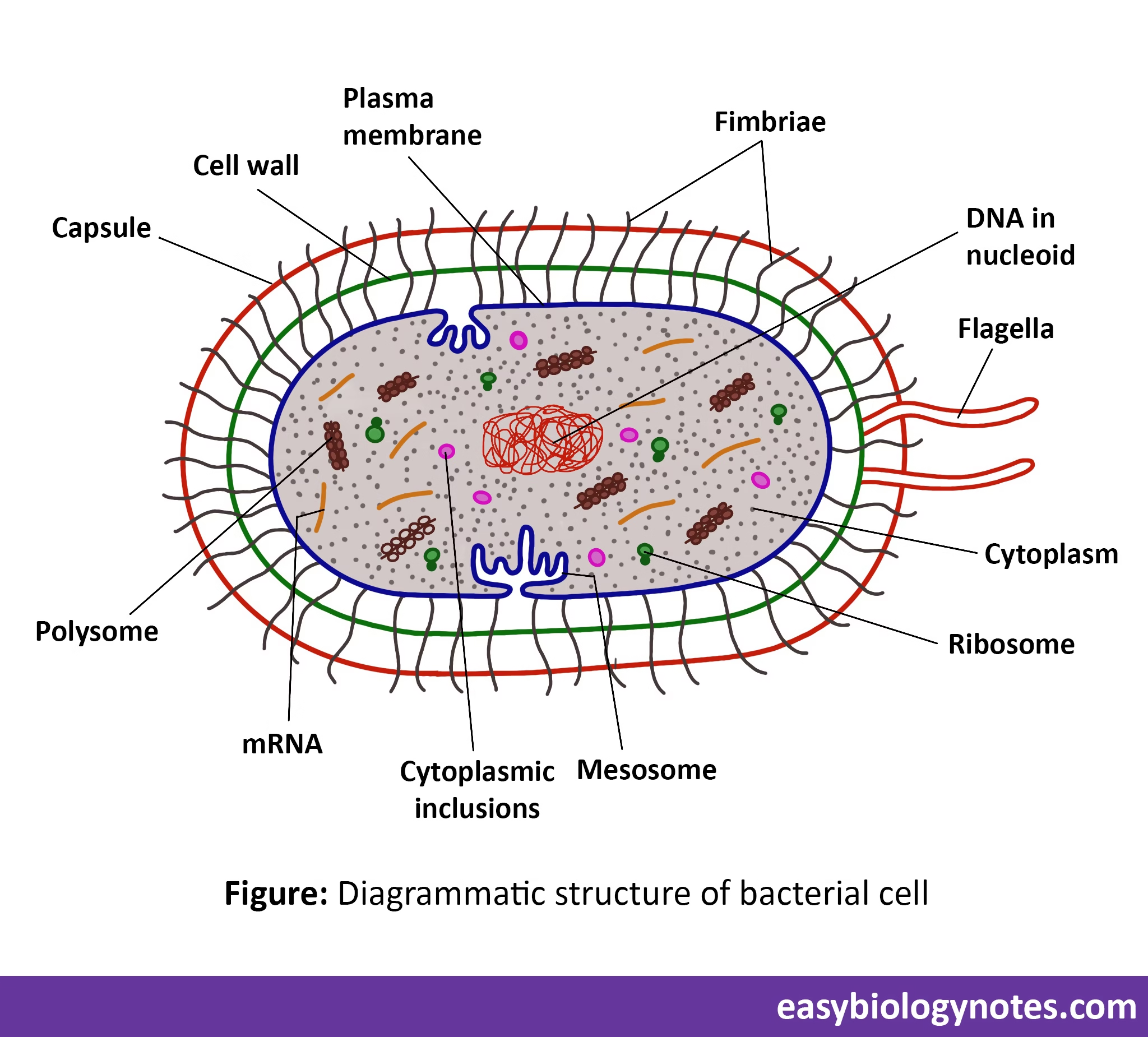What are Bacteria?
- A.V. Leeuwenhoek discovered bacteria in water from different sources and called them “animalcules” (for detail, check history of microbiology in previous pages)
- Bacteria are prokaryotic, unicellular microorganisms which are characterized by their simple cellular structure and lacks membrane-bound organelles such as a nucleus, mitochondria, and Golgi bodies.
Characteristics of Bacteria
- They are prokaryotic and unicellular
- Well organized nucleus, golgi body, mitochondria and other membrane bound organelles are absent in bacteria
- Cell wall is made of murein (muramic acid) or peptidoglycan (in most bacteria cell wall is made of peptidoglycan)
- Cytoplasmic streaming is absent in bacteria
- Major method of reproduction is binary fission
- They are omnipresent
Structure of bacterial cell
Upon observation under microscope several structural components are revealed outside and inside the cell wall. The various structures of a typical bacterial cell are:
- Capsule
- Flagella
- Pili or fimbriae
- Cell wall
- Plasma membrane
- Cytoplasm
- Mesosomes
- Ribosomes
- Nuclear area
- Polysaccharides granules
- Other

1. Capsule
- Some bacterial cells are surrounded by extracellular polymeric substances commonly known as capsule which is gelatinous in nature
- This layer when composed of only polysaccharides, it is known as slime layer and when amino acids (polypeptides) are also present along with polysaccharides, it is called capsule
Functions of capsule:
- It protects the pathogenic bacteria from phagocytosis
- It prevents attachment of bacteriophages
- Also serves as a storage product
2. Flagella
- These are extremely thin hair-like appendages arising from the cell wall and are responsible for motility of bacterial cells
- Flagella is made up of special proteins called flagellin
3. Pili or Fimbriae
- Many gram -ve bacteria possess hair-like appendages which do not function in motility, but are concerned with attachment of cell to cell providing stickiness and are known as pili or fimbriae
- Pili are made up of special proteins called pilins
- Pili differ from flagella in being shorter, thinner, straight and less rigid
- There are some special type of pili known as sex pili which are helpful in transfer of genetic material during bacterial conjugation
4. Cell wall
- Bacterial cell wall is a semi-rigid and complex structure present below the capsule and external to the plasma membrane
- They are primarily made up of network of peptidoglycans
Functions of cell wall:
- Provides shape to the cell
- Provide rigidity to the cell
- Protects cell from adverse environment
- Protects cell from antibodies and harmful chemicals
- Besides peptidoglycan other chemicals such as teichoic acid, protein polysaccharides, lipoproteins and lipopolysaccharides are also present in bacterial cell wall
- Periplasmic space, i.e., space between cell membrane and plasma membrane is also present
- Bacteria falls into two natural groups according to their cell wall structure – Gram positive bacteria and gram negative bacteria
5. Plasma membrane
- Also known as cell or cytoplasmic membrane which is present below the cell wall
- Chemically it is composed of double layer of phospholipids and protein molecules
- Cholesterol is absent in prokaryotic membrane instead of which hopanoids are present accounting for resistance of these organisms to antibiotics
- It controls the entry of organic and inorganic nutrients in the cell
6. Mesosomes
- Cell membrane at certain places become invaginated to form folded structures in form of vesicles called mesosomes
- They are supposed to be analogues to mitochondria of eukaryotic cells
Functions of mesosomes:
- Stores respiratory enzymes
- Involved in cell wall synthesis
- DNA replication
- Helps in reproduction by laying down cell wall
7. Ribosomes
- Ribosomes act as the site of protein synthesis which are present as granules in the cytoplasm
- When attached to the mRNA, they are called polysomes
- Ribosomes are of 70S type made up of two subunits: 50S and 30S
8. Nuclear material
- Lacks a membrane delimited nucleus
- Bacterial chromosome is a single long double stranded DNA molecule which lies freely in the cytoplasm and the region is known as nucleoid
- Sometimes in addition to the nucleoid, bacterial cells also contain small circular self-replicating double-stranded DNA molecule known as plasmid
- The term plasmid was coined by Joshua Lederberg in 1952
- Features of plasmids: • Plasmids are dispensible, i.e., they are not required for the survival of the cell • A bacteria may carry single or multiple copies of plasmids • They provide special characteristics to the bacterial cells like drug resistance, toxin producing ability, etc.
9. Cytoplasmic inclusions
- Different kinds of chemical substances accumulate and form granules in the cytoplasm known as inclusion bodies. For eg: species of sulphur bacteria accumulate large amount of sulphur
- Other inclusion bodies are composed of lipids, glycogen or starch
